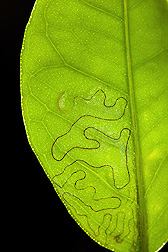Throwing a Citrus Pest Off Its Scent
Agricultural Research Service scientists are working on controlling a pest that poses an increasing threat to Florida citrus groves by exploiting the insect’s own reproductive habits.
The leafminer moth, Phyllocnistis citrella, forms channels as it feeds inside citrus leaves and, as a result, often makes the plant more susceptible to canker disease. Further exacerbating the leafminer problem is the spraying of more insecticide to combat another pest—the Asian citrus psyllid. The insecticide is killing off the leafminers’ natural enemies, allowing the pest to increase in numbers.
Commercial traps can sometimes help, but Stephen Lapointe, an ARS entomologist with the U.S. Horticultural Research Laboratory in Fort Pierce, is exploring a control strategy that has proved effective with other pests: mating disruption. He is collaborating on the project with geneticist Randall P. Niedz and ecologist Terence J. Evens, ARS researchers at the Fort Pierce lab, and with Lukasz Stelinksi of the University of Florida's Citrus Research and Education Center. The experimental design and data analysis were handled by Niedz and Evens, who applied advanced statistical approaches that they have been developing for resolving the effects of different kinds of mixtures in complex biological systems.
Many insects release pheromones to attract mates. In some cases, scientists have synthesized those pheromones and developed treatments that throw males off the scent of fertile females in orchards and fields. The technique has been used to control gypsy moths, codling moths, and several other pests that attack fruit and vegetable crops. These treatments are considered environmentally friendly because they reduce the need for insecticides and are designed to target specific pests. “In all of them, we are basically just interfering with the male’s ability to receive the signal from the female,” Lapointe says.
|
|
Lapointe is working with Lukasz Stelinski of the University of Florida's Citrus Research and Education Center to see whether they can disrupt leafminer mating by manipulating either of two compounds—a triene and a diene—used by female leafminers to attract mates.
The researchers are trying to see whether they can disrupt leafminer mating by manipulating either of two compounds-a triene and a diene-used by female leafminers to attract mates. They also wanted to see what formulations would be most effective at confusing males and disrupting their ability to pick up the female scent.
The researchers created synthetic female-scented traps, placed them in a citrus grove, and counted the number of males caught. They confirmed that the three-to-one ratio of triene to diene worked better than triene or diene alone as an attractant. In 2.5 months, more than 48,000 males were captured in traps baited with the 3:1 blend compared with around 3,500 males captured in traps baited with the triene and only 70 in traps baited with the diene.
In a second phase of the project, the researchers surrounded the female-scented traps with 17 different combinations of the two synthetic compounds—as well as each compound on its own—to see which would be most effective at preventing males from finding the traps. They placed the experimental treatments around female-scented traps at different points inside a 59-acre grove of grapefruit trees. If the experimental treatments prevented the males from reaching the female-scented traps, the males theoretically would be unable to find females in natural settings, the researchers say. They used a waxy substance known as “SPLAT” that slowly released the experimental treatments over time, and they checked once a week over several months to see which treatments were most effective at keeping leafminers out of the female-scented traps.
|
|
Results showed that either compound used alone was as effective as the 3:1 blend at keeping male leafminers away from the female-scented traps. The diene-only treatment resulted in an 89-percent reduction in moth catches, and the triene-only treatment resulted in an 83-percent reduction. Greater amounts of diene are required to disrupt the moths, but diene is also much cheaper to synthesize, Lapointe says.
The work was recently published in the Journal of Chemical Ecology. Lapointe is also working with ISCA Technologies, Inc., of Riverside, California, a manufacturer of the SPLAT technology, to use these results to develop a marketable leafminer mating-disruption technology.—By Dennis O'Brien, Agricultural Research Service Information Staff.
The research is part of Crop Protection and Quarantine, an ARS national program (#304) described at www.nps.ars.usda.gov.
Stephen Lapointe is in the USDA-ARS Horticultural Research Laboratory, 2001 South Rock Rd., Fort Pierce, FL 34945; (772) 462-5914.
"Throwing a Citrus Pest Off Its Scent" was published in the August 2010 issue of Agricultural Research magazine.









